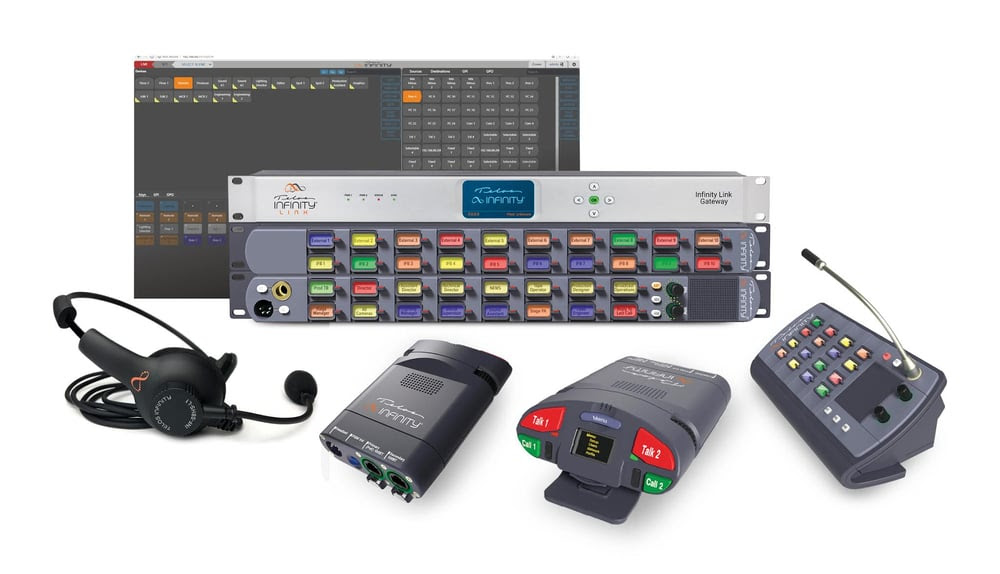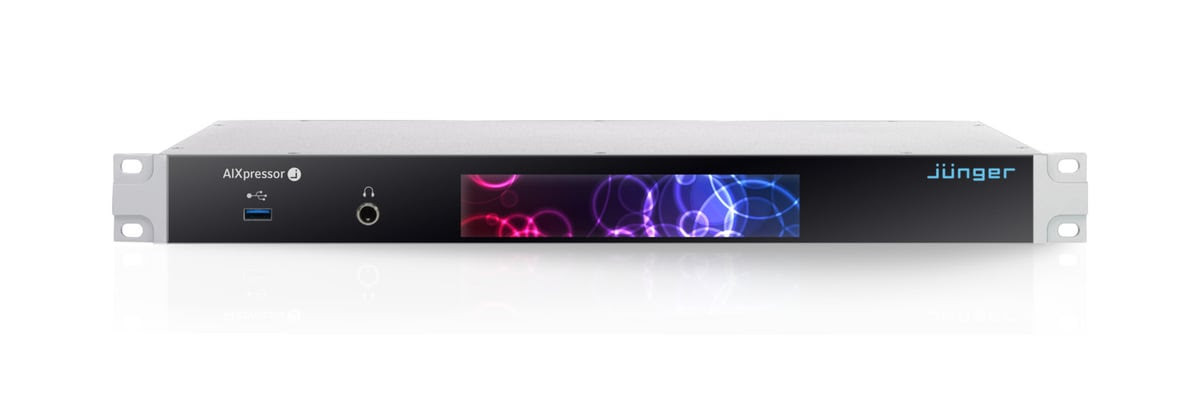Designed for broadcasters by broadcasters, Telos Alliance shows new ATSC 3.0 and Next-Generation Audio products from Linear Acoustic, expanded Telos Infinity IP Intercom lineup, major update to Minnetonka Audio’s AudioTools Server platform, and exciting offerings from Jünger Audio.
JACOB K. JAVITS CONVENTION CENTER (BOOTHS #965 and #N122) / NEW YORK, NY – October 16, 2019.
The Telos Alliance® —trusted global leader in broadcast audio for more than three decades—showed several new products in support of ATSC 3.0 and immersive television audio, as well as updates and enhancements to its existing product and solutions portfolio at AES NY (booth #965) and NAB NY (booth #N122) today, two shows colocated at the Jacob K. Javitz Convention Center in New York.
AES NY INFINITY IP INTERCOM DEMO
Expanded Telos Infinity IP Intercom Platform
New additions to the Telos Infinity IP Intercom platform will be on display at AES NY, booth #965. Additions include Dashboard Advanced software, Infinity Link, and new base models of the Master Panel and Desktop Station. Customers with larger Infinity installations or those who wish to unlock the full potential of the Infinity system will welcome the introduction of the new Dashboard Advanced software which includes System Zone and Scene support, off-line configuration, user rights administration, and support for directly connecting third-party AES67 streams including SAP, and in the future, NMOS nodes.
Telos Infinity Link provides connectivity for Infinity systems installed in remote locations by using embedded, versatile, speech-optimized OPUS codecs to convert WAN-side VoIP (including the Internet) to LAN-side Livewire+ AES67 networks. Infinity Link is available in the form of software licenses that can be added to any host Infinity Panel or Beltpack hardware, or by way of a dedicated higher-density 1RU hardware gateway. Once connected, the resulting Livewire+ AES67 streams from the remote locations appear as sources and destinations within the Telos Infinity Dashboard software and behave just like local networked audio sources, providing the ultimate in flexibility.
Finally, the INF-MP-16B Intercom Master Panel Base Model and INF-DS-16B Intercom Master Desktop Station Base Model offer the same features as the INF-MP-16 Master Panel and INF-DS-16 Desktop Station hardware, respectively, but without the rear panel auxiliary audio I/O and GPIO connections. These cost-effective base versions are ideal for use when local I/O and serial logic are not required.

AES NY Sessions From the Telos Alliance
The Telos Alliance will also be participating in several sessions at the show from various Telos Alliance leaders, including Frank Foti ("Innovations in Broadcast Processing"), Martin Dyster "Reinventing Intercom with SMPTE ST 2110-30"), and Kirk Harnack ("Anatomy of a Stream, "Metadata—What Works, What Does Not and Why?") and ("Emergency Preparedness and Safety for Broadcasters"). For complete details on the Telos Alliance sessions, click here.
NAB NY DEMOS
Linear Acoustic LA-5300 Broadcast Audio Processor Eases the Transition to ATSC 3.0
The new Linear Acoustic LA-5300 offers everything needed to make the transition to ATSC 3.0 as seamless as possible by offering all audio-related functions in a single 1RU package—including support for SMPTE ST 2110-30 and -31 workflows. It provides loudness control via the Dolby® Real-Time Loudness leveler (when encoding to AC-4). Upmixing from stereo to 5.1-channel audio is provided by the new Linear Acoustic UPMAX® ISC algorithm. The LA-5300 can also decode incoming AC-4 streams for confidence monitoring, bitstream analysis, and for audience measurement using the optional Nielsen and Verance watermark encoders. Dolby AC-4 encoding plus Dolby Digital and Dolby Digital Plus transcoding to AC-4 are standard. As ATSC 3.0 adoption grows, support for additional features such as immersive and object-based audio, interactive consumer control, personalized audio and multiple presentations will be incorporated via software updates.

Linear Acoustic LA-5291 Professional Audio Encoder—Supporting Today’s Dolby Atmos Workflows
An essential tool for television broadcasters creating live content in Dolby Atmos immersive audio, the LA-5291 will provide decoding, encoding, and transcoding to and from PCM and select Dolby–coded formats for up to 16 audio channels. Developed in close collaboration with Dolby, LA-5291 is designed to maintain the functionality provided by the Dolby DP591 Audio Encoder, while offering additional features and capabilities. It earns a place throughout the immersive audio journey, starting with OB trucks where it can encode multi-channel PCM audio to Dolby ED2 for contribution or Dolby Atmos for distribution. Further downstream, it can transcode Dolby E and ED2 directly to Dolby Digital Plus and Dolby Atmos and encode PCM to Dolby Digital Plus and Dolby Atmos for final distribution. It features 16 channels of bidirectional AES67 I/O to support users moving toward or currently using SMPTE ST 2110 facilities. SDI I/O will include two independent 3G SDI inputs with de-embedding and re-embedding for up to eight audio pairs and optional quad-link 3G SDI for 4K workflows. Four AES-3 inputs/outputs will be standard, while 64 channels of MADI I/O is available as an option. Dual Ethernet ports will be included, one for AES67 and another for networked remote control via an intuitive, platform- and browser-agnostic web-based user interface. Dual internal redundant auto-ranging power supplies are standard.

Linear Acoustic UPMAX ISC (Immersive Soundfield Controller)
The Linear Acoustic UPMAX ISC builds upon Linear's Hollywood-approved and industry-trusted line of upmixers and carries it forward to meet the opportunities afforded by ATSC 3.0 and Next-Generation Audio systems and integrates into SMPTE ST 2110 workflows. Employing a completely new upmixing algorithm, UPMAX ISC can upmix 2-channel, 3-channel, 5.1-channel, and 7.1-channel audio to immersive audio formats including 5.1+4 and 7.1+4. Upmixing to legacy formats including 5.1- and 7.1-channel audio is also supported, while content presented in native immersive formats is automatically recognized and passed through without processing.

Linear Acoustic ARC Television Loudness Processor
The Linear Acoustic ARC is a budget-friendly, easy-to-use, 2-channel television processor specifically designed for regions and applications that do not require support for multi-channel, coded audio, but where no-compromise audio quality is valued. ARC is SMPTE ST 2110-30-compliant and features Linear's APTO® loudness adaptation algorithm. ARC is simple to set up using any web browser, provides loudness logging for all programs, and is compliant with all global loudness standards including ATSC A/85 and EBU R128.

Minnetonka Audio AudioTools Server Version 5
The industry’s top choice for automated file-based processing just got even better. Representing the biggest update to AudioTools Server to date, Version 5 software represents a complete architectural redesign, resulting in faster, more responsive processing, support for REST API, and the creation of even more sophisticated workflows. Advanced Loudness Adaptation 2.0 includes Netflix compliance profiles. Other improvements include the latest APTO adaptive loudness control algorithm, AutoMix, support for immersive audio formats, Kantar audience measurement watermarking, and a new web UI.

World-Renowned Jünger Audio Processing Available Exclusively Through Telos Alliance
Several of Jünger Audio’s globally respected audio processing products will be on display and available exclusively through the Telos Alliance. Included in the lineup is the AIXpressor, Jünger’s new flagship processor, which brings the power and flexibility of software-based applications to a reliable hardware platform. Its modular design supports all formats including IP-based AES67, SMPTE ST 2110-30, and Dante, as well as a wide range of I/O including analog, AES-3, MADI, and 3G SDI with UHD support. Also on display will be the flexAIserver, a server-based processing platform for Jünger Audio’s processing algorithms designed for high-channel-count applications, and EASY LOUDNESS AoIP, a dual-program stereo processor that brings Jünger’s Level Magic processing to a real-time loudness management platform that incorporates DANTE/AES67 I/O.

|
![]()
